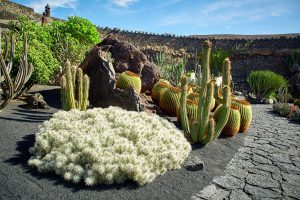The Best Way To Trim A Cactus

Trimming a cactus is a delicate task that requires some specific techniques to ensure the plant remains healthy and continues to grow well. Here’s a step-by-step guide on how to trim a cactus effectively:
Tools Needed:
- Pruning shears or scissors: For small pads or stems.
- Loppers or a saw: For larger or thicker sections.
- Tongs or thick gloves: To handle the cactus safely and avoid injury from spines.
- Disinfectant: To clean tools before and after trimming.
- Dust mask: Optional, for protection from cactus spines.
Steps to Trim a Cactus:
- Assess the Cactus:
- Determine which parts of the cactus need trimming. Common reasons for trimming include removing damaged or diseased segments, controlling size, or shaping the plant.
- Prepare Your Tools:
- Clean and disinfect pruning tools with rubbing alcohol or a bleach solution to prevent the spread of disease.
- If using gloves, choose thick ones to protect your hands from spines.
- Handle the Cactus Safely:
- Use tongs or wrap the cactus in newspaper or a towel to avoid direct contact with spines.
- Alternatively, wear thick gloves to protect your hands.
- Trim the Cactus:
- For Small Pads or Segments:
- Use clean, sharp pruning shears or scissors.
- Make clean cuts close to the base of the pad or segment, avoiding jagged edges.
- For Larger Sections:
- Use loppers or a saw for thicker branches or stems.
- Cut back to a healthy, viable part of the cactus. Make clean cuts to reduce the risk of disease.
- For Shape and Size Control:
- Trim evenly to maintain the cactus’s natural shape. Avoid removing too much at once to prevent stress on the plant.
- For Small Pads or Segments:
- Remove Dead or Diseased Parts:
- Inspect the cactus for any signs of disease or rot.
- Remove any affected segments or pads, cutting back to healthy tissue. Disinfect your tools after each cut to prevent disease spread.
- Let Cuts Heal:
- Allow the cactus to callous over before watering it. This helps prevent rot. Place the cactus in a dry, warm location for a few days to a week, depending on the size of the cuts.
- Care After Trimming:
- Watering: Avoid watering immediately after trimming. Resume normal watering once the cuts have healed.
- Sunlight: Ensure the cactus receives adequate sunlight to support its recovery and growth.
- Monitoring: Watch for signs of stress or disease and take action if needed.
Additional Tips:
- Pruning Frequency: Trim cacti only when necessary. Over-pruning can weaken the plant.
- Shape and Growth: Understand the natural growth habit of your cactus to avoid altering its shape too drastically.
- Safety: Always prioritize safety when handling spiny plants. If you’re unsure about trimming or handling a large cactus, consider seeking help from a professional.
By following these steps and tips, you can trim your cactus effectively, promoting its health and maintaining its appearance.
Cactus For Sale In Arizona
If you are interested in increasing the beauty of your landscape by buying desert plants, stop by our convenient location at 33840 N. Cave Creek Rd., in Cave Creek. For customers interested in our landscaping services, give us a call at (480) 488-9455 to schedule a visit to your home.
More Articles About Arizona Landscaping
- Tips For Growing Indoor Cactus
- Wood Chips Vs Mulch
- Desert Landscaping Ideas
- 10 Incredible Saguaro Cactus Facts
- Where To Buy Saguaro Cactus
- How To Save A Dying Cactus
- How To Bring A Dead Palm Tree Back To Life
- Landscaping Prices In Arizona
- Landscape Boulders Cost
- How To Take Care Of A Cactus In Arizona | Gardening Tips
- Desert Shrubs
- When are the Saguaro Cactus in Bloom in AZ?
- Mulch vs Compost | Differences
- Garden Soil Vs. Potting Mix | Differences
- What Type Of Water Fountain Should I Buy?
- What is Xeriscape?
- The Benefits of Ground Covering Plants
- Desert Plants
- Common Desert Plants Found in Arizona
- Garden Water Fountains
- Types of Cactus
- Different Types of Water Fountains for Your Garden
- Desert Landscaping Phoenix
- Sonoran Desert Landscape Rocks
- Arizona Xeriscape Gardening

